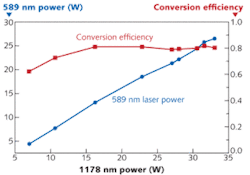A typical laser guide star—formed by illuminating the upper atmosphere with 589 nm light to cause sodium vapor lines to fluoresce—accompanies an adaptive-optics system to compensate for atmospheric turbulence and improve clarity for ground-based telescopes. Fiber lasers (which require frequency doubling or some other scheme to reach the 589 nm wavelength) could not achieve the typical 20 W power levels required for this application, until European Southern Observatory (ESO; Garching, Germany) researchers a 589 nm fiber laser guide-star source using two coherently combined Raman fiber amplifiers, as first reported at Laser, World of Photonics 2009.
Now, the ESO researchers have demonstrated a 589 nm fiber-laser guide-star source with more than 25 W of output power using a single frequency-doubled Raman fiber amplifier.1, 2 Having tackled everything from materials processing to microelectronics processing to medical therapy and harsh-environment industrial applications, the rugged, compact, low-energy-consumption, and excellent beam-quality attributes of fiber lasers can now be applied to guide-star applications in remote telescope locations.
From two amplifiers down to one
To create more than 25 W of 589 nm light, the research team initially fed the output from a 36 mW, 1178 nm continuous-wave (CW) fiber-coupled external-cavity diode seed laser from Toptica Photonics (Munich, Germany) into two 1178 nm Raman fiber amplifiers. The amplifiers were pumped by ESO-built 75 W 1120 nm Raman fiber lasers, which were in turn pumped by ytterbium (Yb) fiber lasers operating at 1070 nm. The 1178 nm amplifier output had a full-width half-maximum (FWHM) linewidth of less than 1.5 MHz and an output power of 20 W before being limited by stimulated Brillouin scattering (SBS). Using a coherent beam-combination technique (consisting of a Mach-Zehnder interferometer formed by a 50/50 fused fiber coupler, two independent Raman fiber amplifiers, and a 50/50 free-space combining mirror), the amplifier outputs are combined (with 95% efficiency) at a single output from the combining mirror and directed to an external resonant cavity for frequency doubling.
The doubling cavity consists of four mirrors in a bowtie configuration and a lithium niobate (LBO) crystal. The 25.4 W, 589 nm output has a measured FWHM linewidth of less than 2.3 MHz with a conversion efficiency of 86%–among the highest ever reported for such a power level.
Because the use of two amplifiers is complex, costly, and less rugged for harsh environments, the ESO team has since used a single Raman amplifier pump to obtain more than 25 W of output for a 589 nm laser. Significantly improved power output from the 1120 nm home-built ESO pump laser allowed the group to eliminate the second amplifier. With the use of a 30 m length of single-mode fiber and a special laser-cavity design, the initial 75 W, 1120 nm source can now produce 150 W of power–the highest-power Raman fiber laser ever reported, to the knowledge of the research team. After frequency doubling of the 1178 nm Raman fiber amplifier, 26.5 W was obtained with a conversion efficiency of 81% in initial experiments (see figure). The authors reported an improved 28 W at Frontiers in Optics 2009.
“Raman fiber lasers or amplifiers are normally not considered ways to generate high-power narrow linewidth lasers because of SBS and nonlinear linewidth broadening,” says Yan Feng at ESO. “However, we have developed techniques to suppress these effects successfully, and proved that a Raman fiber amplifier is actually a promising technology for generating guide-star lasers. A special advantage of Raman fiber devices is the wavelength versatility. The technology can be applied to generate lasers at virtually any wavelength transparent in fibers, and tuned for many other applications in science, medicine, and industry.”
REFERENCES
- Y. Feng et al., Optics Express 17(21) p. 19021 (Oct. 12, 2009).
- Y. Feng et al., Frontiers in Optics 2009, San Jose, CA, post-deadline paper PDPA4 (Oct. 14, 2009).
About the Author

Gail Overton
Senior Editor (2004-2020)
Gail has more than 30 years of engineering, marketing, product management, and editorial experience in the photonics and optical communications industry. Before joining the staff at Laser Focus World in 2004, she held many product management and product marketing roles in the fiber-optics industry, most notably at Hughes (El Segundo, CA), GTE Labs (Waltham, MA), Corning (Corning, NY), Photon Kinetics (Beaverton, OR), and Newport Corporation (Irvine, CA). During her marketing career, Gail published articles in WDM Solutions and Sensors magazine and traveled internationally to conduct product and sales training. Gail received her BS degree in physics, with an emphasis in optics, from San Diego State University in San Diego, CA in May 1986.
